In many games of Commander, a linear strategy is rewarded. An aggressive line, uninterrupted, can make short work of life totals, and an infinite combo that has time to set up can end a game in a flash. But what about the times when you run into a wall, and your strategy is completely bricked? Well, better hope you packed an alternate win condition.
Calculating the End Game

Just as Dr. Strange did in Avengers, you’re going to have to make multiple calculations in a game of EDH to determine your route to success. This calculation can begin as soon as you sit down and spot the decks you’ll be playing against, and should be revised often throughout the game as things progress. You’ll generally reach a point during the mid-game where you’ll know if your current lines of play will be successful or if you’re struggling to keep up. It’s at this point that you’ll know for certain whether you may need to lean on an alternate way to win.
Alternate Win Conditions
Generally speaking, an alternate win condition in Magic is a way to win the game without reducing an opponent’s life total to zero through combat damage. There are many kinds of alternate win conditions, but the ones you’ll most often see in EDH are:
- Those that hinge on pumping large or infinite amounts of mana into spells, like Torment of Hailfire, Exsanguinate, or Comet Storm.
- Those that lock opponents out of the game, giving you time to win at your leisure—think Solemnity plus Decree of Silence, Narset, Parter of Veils and Wheel effects, or ‘Stax’ pieces, like Winter Orb and Stasis.
- ‘Aristocrats’ style combos, which involve a way to sacrifice creatures for free and an on-board way to use that to your advantage. These will usually be cards like Ashnod’s Altar, Phyrexian Altar, Zulaport Cutthroat, Blood Artist, and Cruel Celebrant.
- Two piece combos—cards that interact in a loop. Think Triskelion plus Mikaeus, the Unhallowed, or Sanguine Bond with Exquisite Blood
Generally speaking, these decks are set up to aim for these combos as a primary win condition, and so they will tend to progress their boards and game plans to achieve these goals.
What I’d like to suggest today is this: Just because you’re playing an aggro deck, or a tribal deck, or any other kind of deck that isn’t aiming primarily for a zoned-in alternate win condition; that doesn’t prevent you from putting these kinds of “panic” buttons in your decks, for when things don’t go according to plan.
It’s also worth noting that, should you be building a flexible deck that can win from different angles, it affords you the luxury of more “decision points” as the game progresses. You can be more open-ended in how you begin to get set up, and allow the flow of the game and the cards you draw into to influence your strategy. In martial arts terms, this is the state of flow—not overthinking, relaxing from being too rigid, and allowing pre-determined reactions to become second nature to you.
Let’s look at some problems that can come up, and how you can overcome them with some inventive deckbuilding.
“I can’t do enough combat damage fast enough!”
We’ve all been there. You’re playing an aggressive deck, and you can feel the noose slowly tightening. There are two combo/control players at the table, and one of them is slowly assembling a pillow fort. You have enough resources to kill one of them, but you’re afraid that you won’t have anything left for the remaining player.
It’s one reason why aggro and combat-focused strategies are a lower tier of deck in EDH, and it’s definitely a problem that will come up time and time again. So, how to solve it?
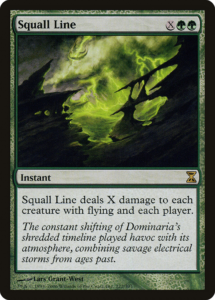
Squall Line is a fantastic card to pack into your mono-Green stompy lists. Sometimes Avenger of Zendikar into Craterhoof Behemoth won’t cut it (and/or you’re bored of the same line of play/are playing a budget deck). You’ll have a bunch of damage on board, but not quite enough to kill someone. Squall Line comes in to save you—nobody expects burn in mono-Green. The fact this is instant speed means it can really mess up an opponent’s blocking. Time and time again, players will have worked out how to stay alive through trample, often hanging on by a thread. Squall Line severs this thread.
It’s also great for dealing with two problem opponents at once. If you manage to keep your life total high enough, you can split attacks (often luring players into not blocking as much as they should), relying on Squall Line to do the “rest” of the damage. It’s also not a dead card outside of this scenario, as removing flying creatures does a lot to shore up one of Green’s biggest weaknesses.
Your deck should already be set up to take advantage of Squall Line with ways to get lots of land into play or mana doublers like Nissa, Who Shakes the World, Regal Behemoth, and Zendikar Resurgent.
“I can’t do combat damage at all!“
With the emergence of Lord Windgrace as a solid lands-based Commander, and Gitrog Monster and Tatyova evergreen in popularity too, it’s no surprise that you’ll sometimes see cards like Glacial Chasm and Constant Mists . . . constantly. Whilst the Chasm is easier to remove—even temporarily—with land destruction like Ghost Quarter, Constant Mists can be a real issue to deal with. Just recently, I ran into a game where, if I’d actually been counting, Constant Mists had undoubtedly been cast at least twenty times. I was on Aurelia, the Warleader, and the only other surviving player at the table was way behind on resources.
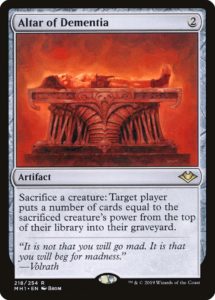
I was able to dig my way out of my predicament by way of recursion, and Altar of Dementia. With Sun Titan, Karmic Guide, and Emeria, the Sky Ruin, I was able to mill my opponent for at least eight cards every turn; and every turn this kept up, I was one step closer to hitting one of my many universal Wheel effects, such as Wheel of Fortune. I knew that as soon as I could hit a Wheel, I stood a good chance of being able to chain through them, as the game had gone on quite a long time at this point (and I was stuck top decking lands!).
I knew there was no way through the Mists, and so going to plan B was ultimately how I would close out the game. It’s important to note that the only reason I got that far was having Scavenger Grounds ready for the Splendid Reclamation my opponent tried to resolve—Scavenger Grounds is so, so good.
“My opponents see my strategy coming. How can I recover?!”
There are times when, despite your brain telling you it’s a bad idea, your heart tells you to persevere. We all have decks that are linear, or a little fragile to interaction, but that we love. One of the most popular new Commanders this year is K’rrik, Son of Yawgmoth. K’rrik is undoubtedly a combo-based deck that wants to drown opponents in value while aiming toward resolving Bolas’s Citadel plus Aetherflux Reservoir. Sometimes, however, your opponents will see it coming, and your life total will be in the ground before you can really get going.
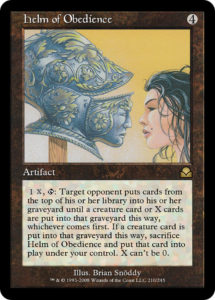
It’s at times like this that an alternate strategy is required, and one of the coolest and down right dirtiest I’ve seen lately is Helm of Obedience plus Leyline of the Void. With a Leyline out, it’s possible to exile the opponent’s entire library, as cards never hit the graveyard, and so the Helm keeps going. This can be a great include in an otherwise fragile deck as a way to claw back a game that is otherwise lost.
It can also slot into decks like Anafenza, the Foremost, who already wants to stop the opponent’s creatures from hitting the bin.
“There’s just too much removal/too many board wipes in my metagame!”
If creatures are rarely surviving, and you can’t keep a board together, consider Revel in Riches. Holding ten treasures and this enchantment on your upkeep might sound like a tall order, but there are many ways in which you can hone this strategy to make this more likely. It’s best to play Revel toward the mid-late game when you already have some treasures stocked up, with some countermagic or ways to ensure it doesn’t just get removed. The best colors for this kind of deck are probably Mardu or WUBR, as it gives you access to Smothering Tithe and Wheels, Prying Blade, Treasure Map, Brass’s Bounty, and ways to make tokens.
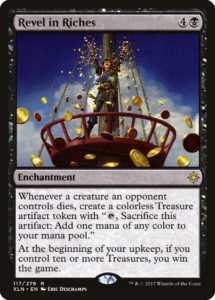
With cards like Saheeli, Sublime Artificer and Brudiclad, Telchor Engineer, you can amass plenty of tokens and convert them into treasure. Pitiless Plunderer and a sacrifice outlet means you can produce treasure in your opponent’s end step before you untap. You can also play some of the extra turns spells in Red or Blue to ensure you get to untap with Revel in Riches. It’s a cute win condition, but one that can catch people unawares if they’ve been dealing with other threats for the whole game.
“My combo has been dismantled!”
Sometimes your primary way of winning the game has been dismantled beyond repair. Your deck relies on intricate synergies and key cards, and is incapable of finishing off an opponent with combat damage—either your creatures are too small, or they’ve mostly been killed and you have no way to get them back. This most commonly happens to combo focused decks, or decks that play an attrition-focused plan.
The best cards to slot into these decks are cards that take advantage of the amount of mana you can generate, or cards that can win the game on their own. Exsanguinate is often an alternate win condition in big mana decks, but slotting it onto an Aristocrats deck as well isn’t a bad plan. In Meren, for instance, your smaller bodies like Sakura-Tribe Elder and Wood Elves will be pulling lands from your deck, and in conjunction with Cabal Coffers/Urborg, Tomb of Yawgmoth package you can realistically have a lot of mana available in the mid to late game. If the chip damage and the continual drain from your Zulaport Cutthroat isn’t enough, Exsanguinate can push you across the finish line.
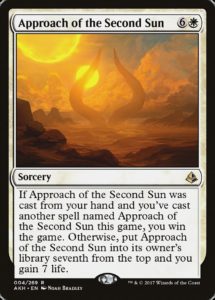
Similarly, cards like Approach of the Second Sun and Mechanized Production can be great incidental cards to answer. Approach of the Second Sun has the benefit that it triggers on cast, too, meaning it won’t even have to resolve. These kinds of win conditions benefit from being virtually untelegraphed—until you drop them, it’s hard to see them coming, especially if your game plan has been largely in another direction up until this point.
Closing Thoughts
All said, I don’t think that adding these kind of cards to your decks and then relying on them is the way to go. I run Exquisite Blood and Sanguine Bond in my Edgar Markov deck; and I never set out to tutor for them, but instead have them as a combo I may naturally draw into or need to consider should things go awry. Similarly, Altar of Dementia is primarily used in Aurelia to shield my creatures from pointed exile removal, or to mill myself in order to set up reanimation. The whole point of playing decks that aren’t focused on combos is to not focus on them, after all!
I also think there’s a way to lean too heavily into alternate win conditions, and that’s playing a deck comprised of entirely two to three card combos or win conditions. One deck that can manage this easily is Niv-Mizzet Reborn. Being able to dig through so many cards to find the right piece can mean that you are never far away from being able to answer the board, giving you time to assemble whatever combo you happen to have drawn into. Having redundancy in combos in a five colour deck is easy, and is in many ways a design choice of its own when you come to build a deck.
In essence: don’t feel bad about playing an alternate win condition, but don’t give into temptation too easily. It’s there for you as a safety net, but the moment you begin to aim solely for it, your deck now has a primary win condition. That’s fine, but not really the point, you know? Make sure your deck has multiple ways to achieve victory—give it a better than 1 in 14,000,605 chance to reach the End Game.
Kristen is a lover of both Limited and Commander, and can most often be found championing the Boros Legion when called upon to sit down and shuffle up. Based in the UK, she works as a software developer, and her love for the Legion is second only to her appreciation for Lord of the Rings and Mass Effect.

